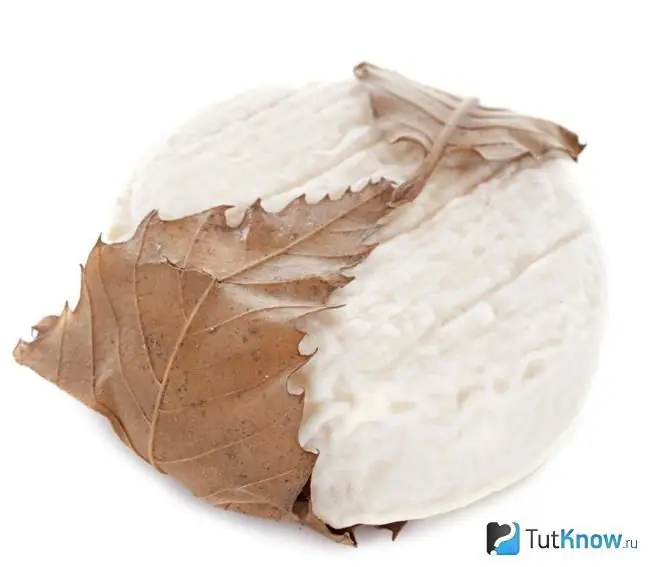- Author Arianna Cook [email protected].
- Public 2024-01-12 17:55.
- Last modified 2025-01-23 09:40.
Features of cooking Banon cheese. Calorie content and content of useful components. Who shouldn't eat this French delicacy? Banon serving rules, its use as an ingredient in culinary recipes.
Banon is a French goat cheese that is classified as a soft cheese. It is produced in the region of the Haute Provence Alps, the city of Banon. One of the oldest cheeses in France, it has more than a thousand years of history. It is alleged that it was served at the table in ancient Rome. The product is AOC certified to ensure geographic location and the highest quality standards. A cheese head of non-standard shape - has the form of a disk about 3 cm thick, weight is about 100 g. Crust - dry, thick, straw-colored with fragments of edible blue mold. The pulp is creamy, holding its shape, but very soft - can be eaten with a spoon. In France, Banon is served with a baked pear and a classic Provence aperitif - blackcurrant liqueur.
Features of making Banon cheese

Making real Banon cheese yourself at home is an unrealistic task. The original production technology assumes the presence of a large number of subtleties and recipe features. Of course, you can cook something like this at cheese making courses, but you can try the original product only in France by buying a head with the AOC marking.
The main features of making Banon soft goat cheese:
- Milk for cooking is taken in pairs, and it is very important to start processing without delay, so that the rennet “grasps”.
- After adding the rennet, the container with milk is “insulated”, the temperature should be kept at 29-35 ° C for 30-40 minutes.
- After curdling, the cheese is laid out for pressing and drying in special forms.
- When the heads are formed, they are necessarily washed with French grape vodka, wrapped in dried leaves of chestnut trees and secured with twine made from palm leaves.
- Then Banon goes to maturation in the cellars, the temperature in which is 11-14 ° C, and the humidity is 90%.
Banon is a cheese of a short ripening time, young varieties are sent on sale after 4 weeks, and mature varieties need 6-8 weeks. As it ripens, the product has a mild, creamy flavor that pungent and tart undertones appear.
The consumption of Banon cheese for a healthy person also needs to be controlled so that the benefits do not turn into harm. It is recommended to eat no more than 50-100 g of product daily.
Banon cheese recipes

Banon is an exquisite and even gourmet snack. The best way to serve it up is baked pears and blackcurrant liqueur. However, cheese also goes well with any fresh fruit, berry jams - especially cherry ones, as well as wholemeal bread. The filling can be replaced with white wine.
When it comes to the product as an ingredient in dishes, it is universal. Let's take a look at some interesting uses in Banon cheese recipes:
- Chicken rolls in bacon and cheese … Buy chicken fillet (700 g), not bone-in. Make a cut in each piece, like a pocket. Grate any hard cheese (2 tablespoons), finely chop the garlic (2 cloves) and parsley (1 tablespoon). Stir prepared ingredients, put Banon (2 tablespoons) and stir again. Stuff the breasts, wrap each in a slice of bacon, pepper to taste. Tie the rolls so they don't unwind and cook for 30 minutes in an oven preheated to 200 degrees.
- Mascarpone and Banon pate … Mix Banon (200 g) and Mascarpone (150 g), add sour cream (5 tablespoons), cumin (1 teaspoon), finely chopped onion, pepper and salt to taste. Cut rye bread (8 pieces) into pieces and fry in butter in a pan until crisp. Cool the bread a little and spread a generous layer of pate over it.
- Baked eggplant … Cut eggplants (4 small) lengthwise and bake for half an hour at 200 degrees. Cool, peel off. Fry the walnuts (40 g). Put Banon (200 g) on each half of the eggplant, bake in the oven at 200 degrees for 5 minutes. Serve with walnuts.
- Pie with cheese and plums … Mix softened butter (70 g) with flour (150 g), sugar (100 g) and yolk (1 piece), knead the dough. Put cane sugar (400 g) in a frying pan, melt it slightly, add plums (1 kg), cardamom, chili pepper, thyme, cinnamon (pinch each). Liquid will be released from the drain, when all of it has evaporated, turn off the heat. Grease a baking dish with oil, spread the dough over the bottom and sides. Top with plum and Banon cheese (100 g). Send to the oven, preheated to 180 degrees, for half an hour.
- 4 cheese pie … Mix softened butter (120 g) with yolk (1 piece), flour (250 g) and salt (1 tsp), gradually stir in water (100 ml). Knead the dough, roll it into a ball and refrigerate for 30 minutes. Mix the cheeses: Gorgonzola (80 g), Camembert (80 g), Grana Padano (80 g) and Banon (80 g) - grate hard cheeses, mash soft cheeses. Separately beat eggs (4 pieces) with heavy cream (250 ml) and pour into the cheese mass. Take out the dough, divide into two parts, roll both out. Line a baking dish with one part, place the filling, place the other part on top. Bake for 30-40 minutes at 180 degrees.
It is noteworthy that in his homeland, where Banon is not treated as a rare delicacy, he is often eaten not in exquisite dishes, but supplemented by the most ordinary ones. Often, for example, this goat cheese is accompanied by ordinary boiled potatoes.
Interesting facts about Banon cheese

There is a tragic legend according to which the Roman ruler Antoninus Pius was so fond of Banon cheese that once he gorged himself, he died of indigestion.
The product is made only in summer, when animals feed on fresh herbs, as a result of which the cheese exudes subtle aromas of Provencal herbs - rosemary, thyme, hyssop and wormwood.
The town of Banon hosts a cheese festival every year. Despite the fact that there is a place for other French cheeses at the festival, Banon is its main guest. That is why the event is organized not earlier than mid-August, so that a fresh "harvest" can ripen.
In 1993, the Society for the Protection and Distribution of the Banon was created in Provence. Despite this circumstance, as well as the AOC labeling, the delicious goat cheese continues to be forged, therefore, even when you find yourself in France, you need to be very careful when buying a delicacy.
In addition to the AOC label, you need to pay attention to the packaging: fraudsters often use synthetic rope instead of natural twine from palm leaves, and instead of dry chestnut leaves - fresh leaves, including those of other plants. Both the first and the second fact indicate a fake.
Previously, Banon was wrapped in paper, but during the reign of Louis XIV, there was a terrible famine in the country. The king ordered everyone to urgently start cultivating edible chestnuts, and therefore these trees are innumerable in Provence today. That is why their leaves have been adapted to be used for cheese packaging.
It is worth noting that the leaves are prepared in a special way: first they are soaked in vinegar, then they are treated with boiling water and only then sent to gentle drying - the leaf should not be too crunchy, but not too elastic, so it will “hold” the cheese well and not break.
It is noteworthy that Banon cheese is actively produced in the USA, but you need to understand that it has nothing to do with French. Yes, outwardly the product is very similar to the real one, but the raw material plays a decisive role in the taste - it is simply unrealistic to cook the same cheese from the milk of goats, which live in completely different climatic conditions and eat completely differently.
Watch a video about Banon cheese:






